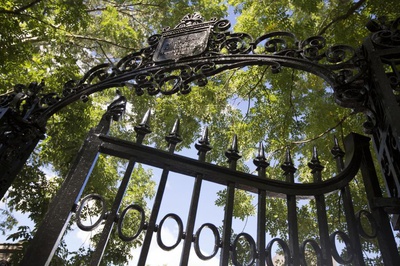
News
Harvard Researchers Develop AI-Driven Framework To Study Social Interactions, A Step Forward for Autism Research

News
Harvard Innovation Labs Announces 25 President’s Innovation Challenge Finalists

News
Graduate Student Council To Vote on Meeting Attendance Policy

News
Pop Hits and Politics: At Yardfest, Students Dance to Bedingfield and a Student Band Condemns Trump

News
Billionaire Investor Gerald Chan Under Scrutiny for Neglect of Historic Harvard Square Theater
CLEARS UP MYSTERY OF ANCIENT MAYAN CALENDAR
Dr. Spinden in Interview Tells How Key Was Found to Enigma--Times Report Wrong Regarding Work in Copan
How he found the solution of the mystery of the ancient Mayan calendar, the oldest time-counting system in the world, was explained yesterday by Dr. H. J. Spinden of the Peabody Museum in an interview with a CRIMSON reporter. Dr. Spinden's latest research work on this problem has been done in the Museum at the University on the basis of voluminous photographs, and not in Central America as recently announced in the New York Times.
"The Mayan calendar," said Dr. Spinden, "passed out of use in 1561 when the Mayan books were destroyed in the Spanish Inquisition. At that time it had functioned for more than 2000 years without losing a day. The dates left on Mayan monuments have puzzled students for many years, and their final solution along the lines laid down by the American school is a distinct triumph over European archaeologists, who have approached the question through their knowledge of the Aztecs. It is now possible to correlate every date in the Mayan calendar with the corresponding date in the Georgian calendar now in use.
"On two hills on either side of the town of Copan in Honduras the ancient Mayans erected two monuments. These points determined a base line, running due cast and west. By standing on the eastern monument the ancient astronomers were able to take accurate measurements of the point at which the sunset. From these observations, which were recorded daily in hieroglyphics, they computed eclipses, and other astronomical data."
As Dr. Spinden explained, the calendar which the Mayans invented, on the basis of records collected by such methods, used several ingenious systems of identifying days quite different from ours. A very troublesome difficulty arose from the fact that the Mayans never dropped leap year days; consequently, their natural year did not always begin on the same calendar day. Dr. Spinden's final solution is too complicated to describe in a few words, since it rests on a great number of coincidences between recorded astronomical events in the Mayan and Gregorian calendars.
"The Mayans invented their system about 613 B. C." Dr. Spinden said, "We know this from the fact that the names of the months, like the "rainy month," signifying the usual weather conditions accord in that period with the known seasonal variations. For 33 years the Mayans tested and perfected their system, and in 580 B.C. it was formally inaugurated." The Mayan era, beginning in that year antedates by almost 300 years the era of Scleucus the oldest known era of recorded time in th old world.
Want to keep up with breaking news? Subscribe to our email newsletter.
From Our Advertisers

Over 300+ courses at prestigious colleges and universities in the US and UK are at your disposal.

Where you should have gotten your protein since 1998.

Serve as a proctor for Harvard Summer School (HSS) students, either in the Secondary School Program (SSP), General Program (GP), or Pre-College Program.

With an increasingly competitive Law School admissions process, it's important to understand what makes an applicant stand out.

Welcome to your one-stop gifting destination for men and women—it's like your neighborhood holiday shop, but way cooler.

HUSL seeks to create and empower a community of students who are seeking pathways into the Sports Business Industry.
